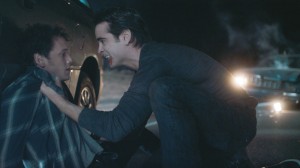Vampires maintain cinematic spotlight
When Fright Night premiered a few weeks ago, Colin Farrell turned heads as a creature not seen in vampire canon for years — a genuine, unrepentant bad guy. Vampires have crept through cinema since 1913 as our flashier, crueler and sexier cousins. But in their century of celluloid glory, there has been a shift. Once, we had soulless undeads in need of stakings. Now we have vampires who sigh and cry and perform caesarian sections on their loved ones. Vampires have had an interesting cinematic life, one that has reflected shifts in our own thinking.

Ferocious fiend · Contemporary portrayals of vampires, like Farrell in Fright Night, serve as symbolic reminders that vampires, although their roles have changed throughout the years, have remained constants. - Photo courtesy of Walt Disney Studios Global Publicity
Vampires have their cinematic roots as supreme evil. In the 1913 silent film The Vampire, the vamp is not an undead ghoul, but a “vamp” in the slang sense of a femme fatale who sucks men dry. Max Schreck’s bat-spider lovechild figure from Germany’s 1922 Nosferatu: A Symphony of Horror remains cinema’s first vision of the horror icon.
Yet vampires also give us a dark thrill. In 1933, Bela Lugosi starred in his legendary role as the charismatic but heartless Count Dracula. Though Lugosi looks different from the Brad Pitts and Ryan Goslings of today, his smoldering Dracula definitely caused a few ’30s housewives to squirm — and not out of horror. The vampire genre also explores less mainstream liaisons, such as the lesbian vampires in 1970’s The Vampire Lovers, which was based on the 19th-century novel Camilla.
Today our fanged friends are softer. They come tortured, lovelorn and achingly beautiful. A teeny-bopper example is Twilight’s Edward Cullen; an older one is True Blood’s Bill Compton. Even more brutal vampires like True Blood’s Eric Northman and Buffy the Vampire Slayer’s Spike come with an “except for my true love” clause.
We have Anne Rice to thank for some of this trend. Interview with The Vampire, the first novel of her Vampire Chronicles, was published in the late ’70s and filmed in 1994. On screen, Brad Pitt’s character spends more time bemoaning his immortality and evading the passes of Tom Cruise and Antonio Banderas than biting jugulars.
Between the ’70s and the ’90s, there are other glimmers of less demonic vampires. Count Dracula is given a sympathetic nod in Francis Ford Coppola’s bombastic 1992 film; he might eat babies and let his brides gang rape house guests, but he really just misses his dead wifey.
These developments partially stem from a shift in our own views. Earlier America was more morally absolutist. There was Superman, good vs. evil and the United States vs. the commies. Over time, for many, this outlook has shifted to moral relativism — a tortured Batman, tragic backstories and a blurred line between right and wrong. Vampires garner sympathy for their harsh existences and thus have more protagonistic roles.
This ambiguity allows for interesting drama. Ferocity and compassion exist in terrifying balance in the 2008 Swedish film Let the Right One In, where a lonely, bullied boy finds a bloodthirsty companion and avenging angel in the vampire-girl-next-door. A more old-school example is Angel from Buffy the Vampire Slayer, who became such a popular character that he got his own spin-off series.
One could argue we sometimes take moral relativism too far and turn our fierce and proud vampires into sparkling heartthrobs with a case of the mopies. At the same time, irredeemably bad vampires like the ones in I Am Legend or the recent Stake Land are shown as more monster than man.
Of course, the appeal of vampires has always gone beyond horror or moral quandaries. Vampires are dark and wild, and therefore sexy. They have eternal life and stamina, and let viewers indulge their dark sides without ending up in jail. As trends are cyclical, it’s no wonder we now have a film like the Fright Night remake, where Colin Farrell vamps out with his bad self. After all the sonnets and love triangles, it’s refreshing to get back to blood sucking. Vampires remain a treasured part of our pop culture, sparkles or not.
Mimi Honeycutt is a senior majoring in print and digital journalism. Her column “Cut to Frame” runs Fridays.
